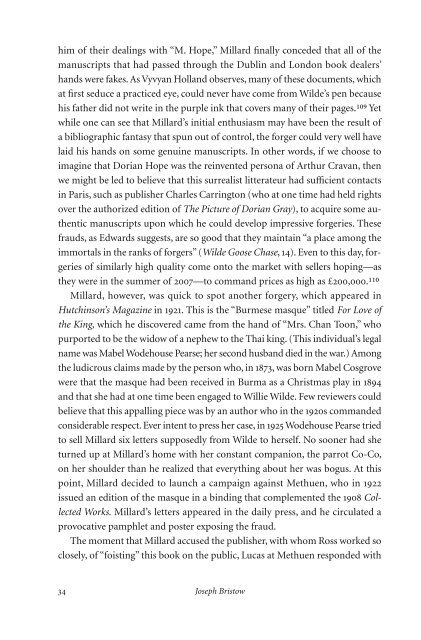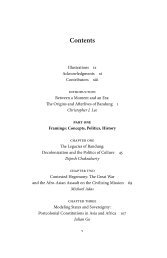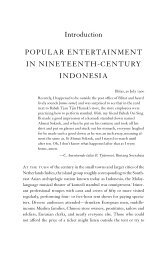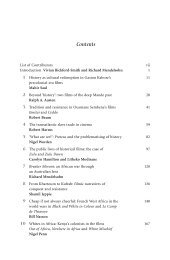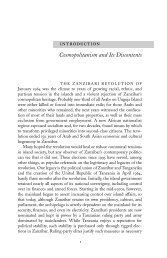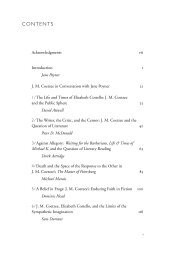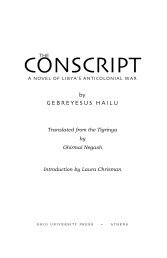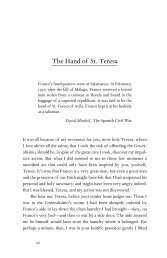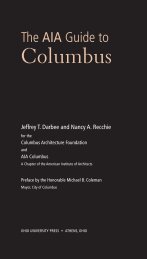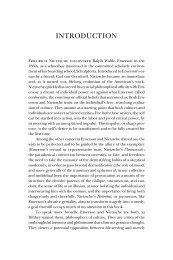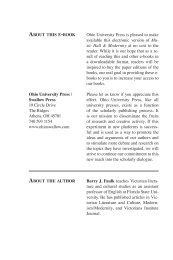Oscar Wilde and Modern Culture - Ohio University Press & Swallow ...
Oscar Wilde and Modern Culture - Ohio University Press & Swallow ...
Oscar Wilde and Modern Culture - Ohio University Press & Swallow ...
You also want an ePaper? Increase the reach of your titles
YUMPU automatically turns print PDFs into web optimized ePapers that Google loves.
him of their dealings with “M. Hope,” Millard finally conceded that all of the<br />
manuscripts that had passed through the Dublin <strong>and</strong> London book dealers’<br />
h<strong>and</strong>s were fakes. As Vyvyan Holl<strong>and</strong> observes, many of these documents, which<br />
at first seduce a practiced eye, could never have come from <strong>Wilde</strong>’s pen because<br />
his father did not write in the purple ink that covers many of their pages.₁⁰⁹ Yet<br />
while one can see that Millard’s initial enthusiasm may have been the result of<br />
a bibliographic fantasy that spun out of control, the forger could very well have<br />
laid his h<strong>and</strong>s on some genuine manuscripts. In other words, if we choose to<br />
imagine that Dorian Hope was the reinvented persona of Arthur Cravan, then<br />
we might be led to believe that this surrealist litterateur had sufficient contacts<br />
in Paris, such as publisher Charles Carrington (who at one time had held rights<br />
over the authorized edition of The Picture of Dorian Gray), to acquire some authentic<br />
manuscripts upon which he could develop impressive forgeries. These<br />
frauds, as Edwards suggests, are so good that they maintain “a place among the<br />
immortals in the ranks of forgers” (<strong>Wilde</strong> Goose Chase, 14). Even to this day, forgeries<br />
of similarly high quality come onto the market with sellers hoping—as<br />
they were in the summer of 2007—to comm<strong>and</strong> prices as high as £200,000.₁₁⁰<br />
Millard, however, was quick to spot another forgery, which appeared in<br />
Hutchinson’s Magazine in 1921. This is the “Burmese masque” titled For Love of<br />
the King, which he discovered came from the h<strong>and</strong> of “Mrs. Chan Toon,” who<br />
purported to be the widow of a nephew to the Thai king. (This individual’s legal<br />
name was Mabel Wodehouse Pearse; her second husb<strong>and</strong> died in the war.) Among<br />
the ludicrous claims made by the person who, in 1873, was born Mabel Cosgrove<br />
were that the masque had been received in Burma as a Christmas play in 1894<br />
<strong>and</strong> that she had at one time been engaged to Willie <strong>Wilde</strong>. Few reviewers could<br />
believe that this appalling piece was by an author who in the 1920s comm<strong>and</strong>ed<br />
considerable respect. Ever intent to press her case, in 1925 Wodehouse Pearse tried<br />
to sell Millard six letters supposedly from <strong>Wilde</strong> to herself. No sooner had she<br />
turned up at Millard’s home with her constant companion, the parrot Co-Co,<br />
on her shoulder than he realized that everything about her was bogus. At this<br />
point, Millard decided to launch a campaign against Methuen, who in 1922<br />
issued an edition of the masque in a binding that complemented the 1908 Collected<br />
Works. Millard’s letters appeared in the daily press, <strong>and</strong> he circulated a<br />
provocative pamphlet <strong>and</strong> poster exposing the fraud.<br />
The moment that Millard accused the publisher, with whom Ross worked so<br />
closely, of “foisting” this book on the public, Lucas at Methuen responded with<br />
34 Joseph Bristow


